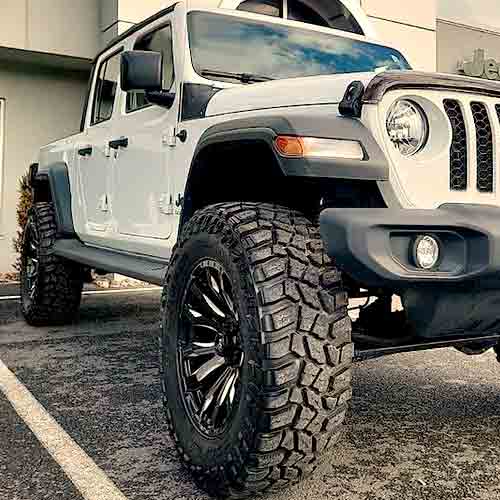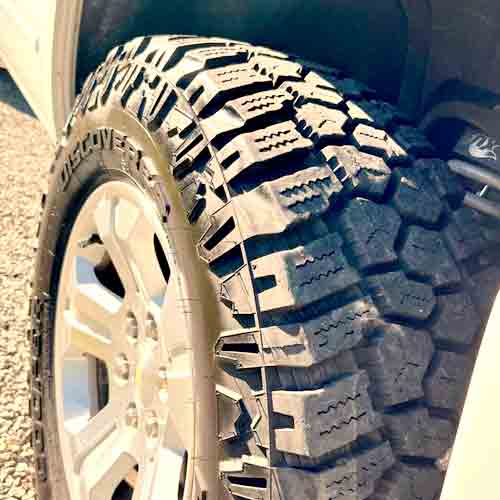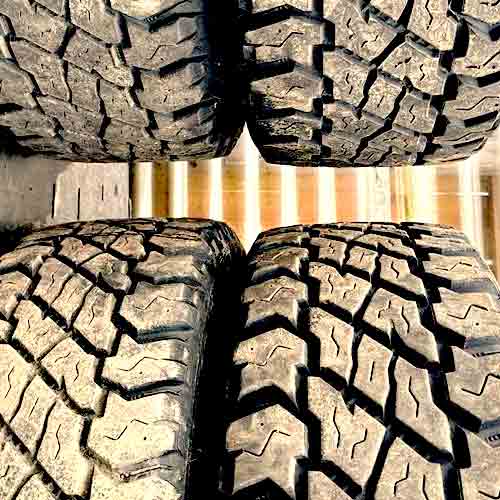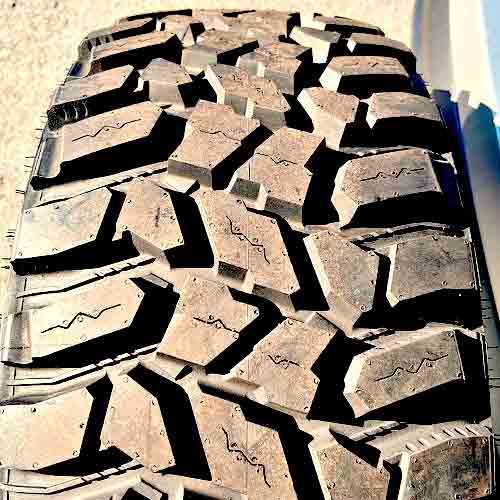All these Cooper Discoverer tires are very different from one another. Here the Rugged Trek is the least aggressive of them all, and the STT Pro being a mud-terrain tire, is the most aggressive, while the Discoverer ST Maxx, sits right in the middle of these two.

Table of Contents
Tire Sizes
Cooper Rugged Trek offers just 18 sizes with following specs.
- 18 total sizes in 16″ to 20″ (rim diameter).
- All have speed ratings in either T or Q.
- Load ratings are available in only XL, E and F, where 265/70R16 and 275/60R20 (only two sizes) also have SL range.
- Tire weight goes form 40 lbs to 70 lbs.
- Tread depth: Either 16/32″ or 18.5/32″.
- All sizes have 3pmsfr.
- LT sizes have 55k miles warranty, while others have 65k.
On the other side, the Cooper Discoverer ST Maxx comes in 47 total sizes in 15 to 20 inches. They have following specs:
- Speed ratings: Only Q.
- Load ratings: C to F.
- Weight range: 38 to 70 lbs.
- Tread depth: 18.5/32″ on all.
- No 3PMSF ratings available.
- No treadwear warranty.
Lastly the Cooper Discoverer STT Pro offers 49 total sizes in 15″ to 22″ rim sizes, coming with following specs.
- All have speed rating of Q.
- Load Ratings: C to F.
- Weight Range: 42 lbs to 94 lbs.
- Tread Depth Range: 18 to 22/32″, where most of the sizes get to have 21/32″.
- No treadwear warranty.
Tread Structure
Let me start with Cooper Rugged Trek.

So this tire has two parts, one less aggressive and one a lot more. So basically you get a hybrid structure capable of going on both on and off-road. And I have to say it’s a pretty well engineered tire.
In the middle the tire gives you directional grip on roads, as the lugs are arranged in longitudinal fashion. So this way the tire remains stable even at higher speeds on dry roads, whereas on wet, the Y shaped sipes help a lot.
And there are no chances of hydroplaning, as these lugs create a web of grooves, which brings me to why this tire is so great off road as well with these lugs.
Basically they are for one haphazardly place. And two, they have a lot of biters and sharp edges to them, so on all types of terrains, you get to have a grip in all directions.
On shoulders the lugs are although pretty spaced apart, and this dampens the on road lateral grip, the reinforced foundational supports still don’t the values to go down by a lot.
Basically all shoulder lugs are placed on continuous running rubber ridges, which also act as stone ejectors, so you get stability as well as self cleaning tread on dirt and muddy trials.
And on rocks with such powerful sidewall lugs you get to have powerful grabbing and pulling.
Moving towards our rugged-Terrain tire, the Cooper Discoverer ST Maxx, you clearly get to have a slightly more aggressive design.

The tire features a symmetric design with central lugs arranged in a slanted lateral positions.
Due to the slanted and lateral orientation of these lugs, the outer grooves of the shoulders get to meet up with the ones in the middle very clearly, and this account for the tread cleaning abilities of this tread.
The lugs are are various shapes and sizes, with sharp edges to them and simply siping pattern (which is full depth).
Moving towards the shoulders, the blocks are bigger here, carrying slightly more interlocking sipes, and sharper edges.
Their outer margins of these studable lugs are although not prominently staggered, each lug is serrated on itself, providing ample bite.
And helping that off-road bite are it’s thick enough sidewall lugs, which come in handy when you run the tire with lowered air pressure.
Moving on to the most aggressive tire of the family, the Cooper STT Pro, you get the bald-most structure here.

The asymmetric tread here features thicker lugs which are also placed in a laterally arranged fashion.
There is only a single rib in the middle forming lugs with very minimal sipes on them (of wave-like pattern), and sharp offset sides).
They look like they are part of the elongated shoulder lugs, divided by longitudinal grooves.
Though the tire only makes lateral grooves as circumferential channels are very tough passing.
Moving towards the shoulders…
The lugs make 2 unique designs. One of them are slightly more elongated than the other, carrying in-groove notches, while the other smaller one is only seen with interlocking sipes.
These lugs are surrounded with wild gaps where bold stone ejectors as ween.
And with staggered outer edges and powerful sidewall lugs, its no wonder why this tire offers the best traction out of all when ti comes to off-road rugged terrains.
Durability
In case of durability which mostly depends on internal construction (particularity from sidewalls), the Cooper Discoverer Rugged Trek lacks the most with it’s just 2 ply polyester casing with 2 steel belts on top and single nylon reinforcement.
Whereas the Cooper ST Maxx, and STT Pro with 3 ply carcass offer much better protection.
And comparing these two, I have to say both of them offer equal durability. I mean sure, the STT Pro offers thicker rubber on top of those 3 ply sidewalls, but on Cooper ST Maxx, the 3 ply polyester casing has its 3rd layer at an angle which basically enhances its strength.
Wet Traction
When it comes to wet traction, the sipes (on the tread), significantly influences overall performance. And in this aspect, the Cooper Rugged Trek, with its more number of those sipes, along with their better structure, excels.
On this tire, these sipes have an interlocking structure, which basically stay flexible even during the tire taking harsh turns or braking abruptly (for example).
But why is flexibility important, you ask? Well, because sipes literally suck water particles in their slits, and that’s how they clear off water so the rubber can grip the road. And they can’t do that without being flexible.
The Cooper ST Maxx, despite providing an all-weather rubber blend with a generous amount of silica in its new generation tread (which gives flexibility), still falls short in comparison, due to its fewer sipes.
Though still it still does better compared to STT Pro which lacks the most when it comes to siping.
Dry Capability
The assessment of an off-road tire’s dry performance requires a thorough evaluation of two main features: directional grip and cornering ability. Lets talk both, starting with the grip.
Dry Grip
In the domain of tires, a “balder” design struggles the most with grip. This is because grip is made when the rubber (effectively) meets up with the road, and voided tires can’t do that.
This explains why the aggressively designed mud-terrain Cooper Discoverer STT Pro, with its expansive voids, falls behind here.
Whereas the Cooper Rugged Trek with it’s much closed up central area allow for better braking distances (a direct measure of grip, which is also called directional grip because of that).
But why central area? Well because that area gets the most weight concentration on itself, when the tire rolls straight, like on highways, for example.
The ST Maxx on the other hand, features wide lateral tread voids in comparison, and the STT Pro gets to have even more wider tread designs so they both lack to their counterpart.
Handling
A tire’s overall handling largely depends on two crucial elements: tread flexibility and shoulder lug design.
The shoulder lugs design basically tells how much footprint the lugs make, and in this regard, since there isn’t much difference between all of them, it can be only explained with the tread flexibility why the Cooper Rugged Trek showcases the fastest of all handling times.
So as the tire turns, the weight it carries, gets shifted towards the tread extremities, i.e. shoulders, and how much lugs bend there tell you about the handling.
With greater weight, lugs tends to bend a lot more, and so that causes unbalanced understeering and oversteering, ultimately slowing down the steering response and affecting overall handling effectiveness.
And so in this regard, the Cooper Discoverer Rugged Trek makes an impressive case with its lighter overall design.
Moreover all its shoulder lugs also have reinforced foundations underneath, so this further adds to overall lug’s resistance against bending.
In contrast, the Cooper STT Pro, with its more flexible compound and missing block support, exhibits a higher propensity for oversteering and understeering.
And same goes for its Discoverer ST Maxx variant as well. The tire has a lot of tread depth, a softer compound and much greater weight. All of these factors contribute to excessive lug bending, resulting in reduced handling efficacy.
Rugged-Terrain Traction
It seems intuitively clear which tire should outperform the others, off-road. However, to confirm these assumptions, I subjected all three contenders to various terrain tests. Check them all below.
Muddy Trails
Mud traction depends significantly on two factors (on a tire): effective self-cleaning and adept scooping, or you can say, paddling skills. And as expected, the mud-terrain variant surpasses their all-terrain or rugged-terrain counterparts in this slimy contest.
Basically the Cooper Discoverer STT Pro, besides providing a highly voided structure, also supplies a very laterally oriented design. This allows the tire to not only come out better here, but also when compared to other mud-terrain tires (famous ones, I mean).
While its huge tread voids escape out the thick wet debris, its laterally aligned central lugs, combined with elongated shoulders, provide amazing paddling abilities, throwing back the thick ground, and generating forward momentum out of it.
In contrast, both of the other two tires, don’t stand a chance here. But it was surprising to see that the Rugged Trek actually outperform the Cooper ST Maxx.
And that’s because the tire offers better tread extremities. It’s equipped with shoulders, having proper mud scoops, along with dual sidewall designs.
Whereas the Cooper ST Maxx has no proper mud scoops, and is really missing with sidewall lugs, I mean they are there, they can really be improved.
On Sand
Sand is another soft terrain, just like the mud, where you need a lot of paddling efficacy, out of your tires. Though here, tires also need to be able to float properly.
So how much pressure they exert on the surface, is one of the most crucial points here.
And here, the Cooper Discoverer STT Pro takes the lead. The tire although is heaviest of all three, its thicker sidewall lugs spread out, with lowered air pressure, and still account for good enough contact patch, improving overall floating abilities.
The Cooper Rugged Trek comes in 2nd here, with its combination of knife shaped elongated sidewall lugs, and lighter weight.
The Cooper ST Maxx, again lacks here a lot with its missing proper sidewall lugs, and sharper outer edges, which are more prone to digging.
Rocks
Successfully navigating rocky terrains requires some serious durability, along with multi-angled grip. And as these factors are best provided here by Cooper STT Pro, this tire takes the lead by some margin, I should add.
Here both the Cooper ST Maxx and the Rugged Trek are a little off, though because of very different reasons.
The ST Maxx like already mentioned is missing with proper sidewall lugs, so with lowered air pressure, their isn’t much enhancement made to the tire’s overall grip.
And on the other hand, the Cooper Rugged Trek lacks in the durability department. It although features a very aggressive outer tread design, its inner construction only consist of 2 ply polyester casing, and that is not enough for this most puncturing terrain out there.
Fuel And Tread
The structure of a tire and the stickiness of its tread, is what contributes to overall fuel economy.
Considering these factors, it’s not surprising, that the Cooper Rugged Trek offers superior performance here, with it’s lighter structure (compared to other two).
Unlike the other two tires, the Rugged Trek features only 2 ply sidewalls, and sure it compromises on durability a lot, it also boosts its overall MPGs too.
On the other hand, with softer tread compounds, and greater weighing structures, the Cooper Discoverer STT Pro and ST Maxx both really lack. Their lugs flex a lot more causing wastage of energy, that could otherwise be consumed in rolling the tire.
And they also get to more susceptible to burning too, as those lugs have more weight pressure on them.
That’s why these tires don’t come with any warranty, whereas Rugged Trek gives you up to 65k miles (for P metric sizes, and 55k for LT).
Road Noise
Noise generation in tires can be attributed to numerous factors, primarily resulting from the interaction of air and tire treads. Here the impact makes the noise, and with that, since noise bounces off the walls of the tread, the in-groove resonance also gets generated.
And with a more voided structure, the Cooper STT Pro tends to produce most of these noise types out of all three.
Conversely, the Cooper Rugged Trek and ST Maxx tires, with their densely packed lugs, restrict excessive air inflow.
But still the Rugged Trek takes the bigger piece of the pie, out of them all, because of its Whisper Groove Technology.
Since the majority of the air enters through the shoulders voids, this tire features blockers (which is the technology) in these areas to limit that air movement, so minimum of it hits the (tread) walls to create noise.
Winter Performance
The all-season capabilities of off-road tires have seen a considerable improvement over time. Presently, most of these tires not only ensure reliable traction during the summer but also excel on snow-covered terrains.
Such advancement is evident in many tires, including the Cooper Rugged Trek as the tire carry the 3 peak mountain snowflake rating (unlike its two bigger brothers), indicating its enhanced ability to handle severe snow conditions.
But what makes this tire better? Well, a couple of things, first off, it has a lot of biters which grip the icy and snowy surface, and its tread voids are arranged in a way, so as to facilitate its snow holding abilities.
With that, basically the tire gets to form larger snow to snow contact which generates greater friction (compared to when rubber meets the snow).
Moreover the tire also features thermal adaptive thread rubber, which stays pliable even with freezing temperatures.
The other two tires, the ST Maxx and the STT Pro both lack all of these features, so they can’t keep up when it comes to on-road snow, however, they are still okay for deeper terrains.
Key Takeaway
Let me summarize all the things discussed above.
The Cooper Rugged Trek shines in terms of fuel efficiency and tread longevity due to its lightweight design and stable lugs. And it also performs admirably in terms of wet and dry traction, thanks to its better structured siping.
And although noise isn’t the tire’s strongest suit, it’s still better compared to its bigger brothers, as the tire incorporates Whisper Grooves Technology.
Though off-road is where the Cooper STT Pro excels the most, in all departments.
But it was surprising to see the STT Maxx lacking a lot here, mainly due to its missing sidewall lugs.